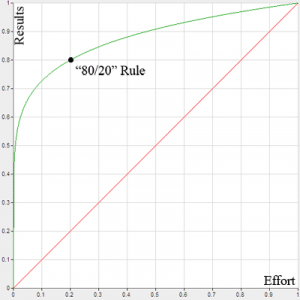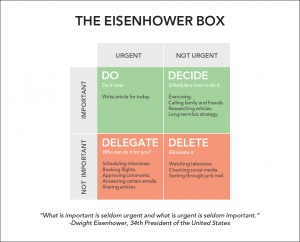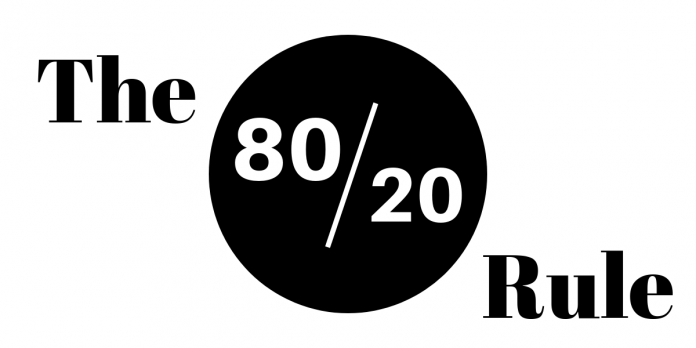This article is written by Suman Chatterjee Team LawSikho.
Vilfredo Federico Damaso Pareto, an Italian economist and sociologist, found out that 80 per cent of the results came from 20 per cent of the action.
Legend has it that the idea cropped up one day when he noticed how 20% of the pea plants in his garden generated 80% of the healthy pea pods.
Then he looked at the distribution of the nation’s wealth.
Following that, he did a study on industrial production and discovered that 20% of the companies contributed 80% of the production volume.
A pattern emerged which came to be known as the Pareto principle, also known as the 80/20 rule.
And today, it is one of the most famous and widely talked about principles that fascinates many experts in many occupations.
And its application can be found everywhere.
And you can be highly productive or successful if you can spot the 20% of the opportunities that produce 80% of the results, and ignore the rest. Or maybe you can cut out 80% of your activities today and focus 100% of the efforts on just the 20% that produces most results because that can drastically improve your outcomes.
…including in the legal profession.
That is what I will be talking about in today’s article.
What is this Pareto Principle? How can you use this principle in your legal practice? Whether it will be beneficial or not?
If you have not heard about the principle, you will love this article.
If you have already known about this principle, you already know you can’t afford to miss this.
What is the Pareto Principle?
The Pareto principle is simple. Let’s look at a few examples first.
- 20% of criminals commit 80% of crimes
- 20% of drivers cause 80% of all traffic accidents
- 80% of the pollution originates from 20% of all factories
- 20% of the workers produce 80% of the results
- 20% of companies products represent 80% of sales
- 20% of the product features cover 80% of the usage
- 20% of employees are responsible for 80% of the results
- 20% of students have grades 80% or higher
- 20% of lawyers rake in 80% of the clients
- 20% of law students secure 80% of the internships
And so on.
What Pareto principle actually indicates is that twenty per cent of a certain input (effort, time or labour) results in eighty per cent of output.
What we need to understand is, this is not a hard and fast mathematical rule, and it is not set on the stone that 20 per cent of “whatever” will always result in 80 per cent of “whatever else”. It can be that 10 per cent of the inputs will result in 90 per cent of the outputs, or that 20 per cent of the action might even bring in 100 per cent of the results.
It’s that the sum of the percentage of input and that of the output always has to be 100 per cent! The cardinal principle is that a minor percentage of input will lead to a major percentage of output.

Image courtesy: betterexplained.com
Is the Pareto Principle the same as the Eisenhower Matrix?
Heard of Dwight Eisenhower ever? He was the 34th President of the United States, serving two terms from 1953 to 1961, and perhaps, one of the most active ones for that matter.
During his time, he facilitated the development of the Interstate Highway System, the exploration of space (NASA), the unveiling of the internet (DARPA), and ushered in the peaceful usage of alternative energy resources via the Atomic Energy Act.
He was a 5-star general in the US army and acted as the Supreme Commander of the Allied Forces in WWII. He led several invasions in North Africa, France and Germany.
He also served as the President of Columbia University and also became the first President of NATO. Amidst all these, he also actively pursued golfing and oil painting!
Talk about productivity, and Eisenhower’s name has to be taken. How could someone uphold his productivity not for a few weeks or months but for decades? Apparently, it was by following a simple model called the Eisenhower Box (or Eisenhower Matrix).

Image courtesy: jamesclear.com
Eisenhower suggested our tasks be organized into four categories as follows:
- Urgent and important (tasks you will do immediately).
- Important, but not urgent (tasks you will schedule to do later).
- Urgent, but not important (tasks you will delegate to someone else).
- Neither urgent nor important (tasks that you will eliminate).
Eisenhower believed, “What is important is seldom urgent and what is urgent is seldom important.” What makes this matrix impressive is that it can be used either for your broader, long-term goals or for your shorter, day-to-day activities.
Now, is the Pareto principle the same as the Eisenhower Matrix?
In the Eisenhower Box, the task that is both urgent and important is of the highest priority. If something is urgent but not important, delegate it to someone else. If something is important but not urgent, schedule it for later. If a task is neither, forget about it!
As per the Pareto principle, only 20 per cent of the tasks are urgent and important since they result in 80 per cent of the results. It’s wise to recognize these 20 per cent that is both urgent and important and blast at them before anything else.
Both these principles are, in their own way, talking about the same idea, and when combined, you will know what to do, when to do and how to do it.
Eisenhower was a military man, of course. No time for confusion or nonsense. He knew two words in life: goals and missions.
What about you?
The biggest mistake by Pareto followers
This is based on my personal observation where I have seen that most Pareto principle followers fall short in one aspect, that is, consistently and dedicatedly following it.
They might know what their “20 per cent” activities are and they would still not continue doing them for as long as they should. They would leave it midway after getting some results. They would be happy with the results they got from the action taken so far, and run after yet another shiny object they came across recently.
A big mistake!
There’s a saying, “don’t break it as long as it’s working.” If a tactic is working for you, why would you stop doing it? Why would you want to try out something new and exciting? Sure, greed wants you to go for greener pastures but is it worth it? Often, it is not.
What you might do is stack one successful tactic upon another. But to stop one successful tactic in the hope of another one yet untried and untested is not what a wise man would do.
Neither should you.
Once you figure out the “20 per cent” inputs that bring in 80 per cent of the output, keep doing it until it stops working. That’s how successful people operate.
So, now that you know about the Pareto principle…
How can you use the Pareto Principle in your legal profession?
What we are basically asking is, how you can be 10x more productive and effective in your daily activities. As a lawyer, your primary goals are probably acquiring newer clients, serving them better and finding more and more work opportunities.
(If you are a law student or an in-house lawyer, this might not be true for you. You can still apply the logic in your daily life though.)
Getting newer clients
To apply the 80/20 rule in your marketing and promotional activities, first, check out the statistical data to find out what is working and what is not. If you are indulging in a multi-pronged business development strategy, chances are that some are contributing more towards the results than others.
Does calling existing clients pull in more conversions than writing articles on legal issues? Does working on consensual divorce matters bring more revenue with fewer efforts or are contentious divorce matters better? Should you keep writing and publishing legal research articles like you usually do? What about the business cards, the lavish parties or seminars? Is that one webinar getting more views than the podcast channel you have been running over the last couple of years?
Only if you go deeper into the numbers, you will know the truth. When you find out which activities are working better than others, focus all your efforts on maximizing that.
Better and fuller services
When it comes to serving your clients, think back and find out what services have been most preferred by your clients. Were you getting more tax-related work from your friends and family? Or perhaps, your residence behind the local thana procured you more criminal legal work than anything else?
When were your clients extremely happy with what you did? When did the refer other clients to you on their own? When do clients take out trouble to thank you, send you birthday messages or gifts on your anniversary maybe?
It might be that you have been closely connected to the medical industry and your network is filled with healthcare professionals. How can you capitalize on that?
It might also be that your current client who hired you for a GST filing is also looking for someone to write the memorandum and the articles of association (AoA).
Consider that in all that you are doing and not doing, there is something that is a small shift, but will create disproportionate results. Are you even looking for it?
What is the 20% in your work that got you 80% of your revenue last month? What if you left everything else and pursued just that 20%?
What I am driving at is that your circumstances can be a big factor in the type of work that you usually get. Figuring out what your clients need or what kind of work is available in plenty for you can help you decide which services to focus on.
If you focus on those services to the exclusion of others, you might be able to serve your clients better and more effectively and produce results that you never thought possible.
It will sound like crazy talk to many of you! But this is how hyper specialised hyper profitable law firms you have heard of have been set up.
If you ever come to think that there is a dearth of legal work, stop and rethink. You might be missing out on an opportunity that’s lying just under your nose because you focus on a lot of things rather than focussing on what produces 80% of your profits!
More and more work opportunities
Reassessing where the opportunities lie from time to time must be a part of your business development routine. In today’s dynamic commercial world, the landscape changes “fast and furiously”.
Unless you are drifting your career car deftly through the legal streets, you might not be able to keep up with your peers and fall behind.
(I am a big fan of that movie series in case you are wondering.)
For example, look at the current crisis. Many lawyers who had a thriving legal practice or their juniors who were starting to see some quality work finally coming their way are sitting idle at home now.
Is there a dearth of work today though? Nope, not at all. Only if one knows where to look, and how to gear up for it, work will be bestowed aplenty.
Once you do know where these opportunities lie, the idea is to focus more on acquiring the legal skills to be able to cater to those clients.
In college, they do not focus on training you for the skills that will make you money.
But imagine that there are 20% skills, which if you learn, it would make you the majority of the money.
This is what we follow while building a LawSikho course.
We teach you that 20% skill that will help you to capture 80% of the market or help you to do 80% of the work that will come across your desk in a law firm or litigation chamber so well that you really stand out.
And then there are opportunities according to market swings.
Say, M&A and investment-related legal work are likely to see an upswing at the moment. VC funds are sitting on massive funds and they will have to deploy those funds soon. Even the arbitration niche is rather hot while banking and finance is yet another golden opportunity for lawyers during this crisis period. 20 per cent of legal niches have the potential to generate 80 per cent of legal work during these times.
We have built the training programs that can rapidly upskill you for these opportunities.
What should you do? Upskill yourself for these particular legal niches.
Wondering how to upskill yourself while you are stuck at your home? Your favourite LawSikho course is a great option for sure.
How we use the Pareto Principle in our courses
Every LawSikho course is designed in such a way that we follow the Pareto principle and help you learn those skills that are most essential for you to get work opportunities, as an intern or as a lawyer.
The longest any of our courses run is for 12 months. We do not want to stretch it further. Our aim is to pack as much value as we can in the shortest time period possible. For that reason, we cut out the unnecessary “fluff” and only include the practical knowledge, along with actionable insights, in our course curriculum. Only the most valuable skills that make you sought after in the industry.
We know that most of you who join our courses have already passed your law school or are probably pursuing their LLB degree, so we usually try to bring in what your law school can’t — real-life experience from real-life legal experts. Our industry panel consists of over 80 lawyers, industry experts and retired judges at present.
We also guide you on how to write legal research articles with a target of at least one article per month during your term. Legal article writing not only helps you tighten your written communication skills but also pushes you to study case laws, case studies and develop a deeper understanding of the subject matter.
We also focus a lot on legal drafting in almost every one of our courses. Our research says that one of the most common tasks a junior lawyer gets allocated to do is draft legal documents.
We ensure that once you graduate from our courses, you are able to draft the most commonly used legal documents in your chosen legal niche.
We even provide you with regular internship and job opportunities, and we will even groom you personally to upgrade your resume and improve your communication skills to be able to avail these opportunities.
We understand the most “urgent and important” part of your legal studies, that is, to start a successful legal career. In our courses, we aim to equip you with every legal skill required to get a jump-start and take your career to the next level.
Want to know more about how we do it? Talk to our career counsellors on 011 4084 5203 and have a free consultation, or comment below to this article with your phone number and a message “What makes a LawSikho course special?” Our counsellors will reach out to you.
Or check out our full course catalogue here.
What kind of articles are you looking for?
We are trying to provide you with better and better emails every day.
Though we focus on providing value emails almost every day, we want to know what kind of emails you would prefer to receive.
Should the emails be as long as they usually are or shorter?
What legal topics should we cover in the upcoming days?
Would you like more images and graphics? Or text suits you better?
Should we include the latest judgment summaries, news updates, etc?
Anything else you have in mind?
Looking forward to your comment.
To your success.
P. S. LawSikho is running hour-long webinars every day. Want to learn how to improve your learning skills? Prepare an LLM application to a foreign university? Career opportunities in new, upcoming areas of law? Don’t miss these high-quality webinars with industry and academic experts.
P. P. S. All our premium courses are covered under an unwavering 45 days full money-back guarantee.
After taking a course, if you feel like it is not working out for you, maybe you are not getting enough value out of it or it is not meeting your expectations, just get in touch with us. We will refund every rupee you paid for the course.
No questions asked, as long as the minimum requirements of the refund policy are fulfilled.
LawSikho has created a telegram group for exchanging legal knowledge, referrals and various opportunities. You can click on this link and join:
https://t.me/joinchat/J_0YrBa4IBSHdpuTfQO_sA
Follow us on Instagram and subscribe to our YouTube channel for more amazing legal content.











